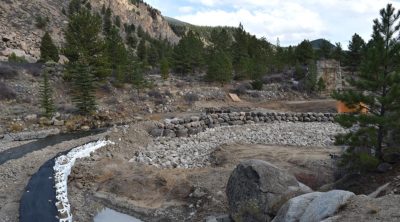
Seen from upstream, the Homestake project includes a stone wall that will form the side of the boat chute on river left. Once the construction project is complete, the structure will include a fish ladder on river right (photo by Joe Stone).
The cities of Colorado Springs and Aurora have begun rehabilitation of the Homestake Arkansas River Diversion south of Granite, which will include a boat chute and a fish ladder to improve river conditions for boaters and fish.
The original Homestake diversion was constructed in 1964 as the intake for the Otero Pump Station, which delivers West Slope water from the Homestake Water Collection and Storage System to the Front Range.
Since that time, the upper Arkansas River has evolved into one of the most heavily used sections of river in the U.S. for whitewater recreation, a Gold Medal trout fishery, and an important water supply and delivery system.
Conceived by the city of Aurora in the late 1950s, the Homestake system is jointly operated by Aurora and Colorado Springs. The system consists of collection and diversion structures in the headwaters of the Eagle River, Homestake Reservoir in Eagle County, the trans-mountain Homestake Tunnel, the Otero Pump Station and the Otero Pipeline.
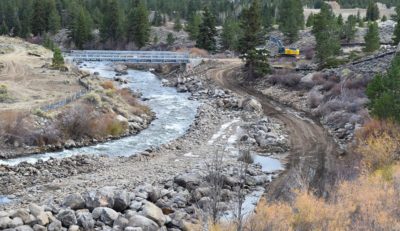
A temporary bridge crosses the Arkansas River downstream from the Homestake diversion. Workers installed the bridge to move construction materials and equipment to the east side of the river (photo by Joe Stone).
The Homestake system also uses elements of the Fryingpan-Arkansas Project, including Turquoise Reservoir and Twin Lakes Reservoir.
In fact, Homestake water is primarily delivered to the Otero Pump Station from Twin Lakes Reservoir, bypassing the original Arkansas River diversion. However, the diversion remains an important alternative for delivering water through the Otero Pipeline when needed.
The original structure was not designed to be navigable and is considered the only non-navigable section of the Arkansas River between Leadville and Cañon City, according to the project web page. The diversion also prevents trout from swimming upstream to spawn.
Rob White, Arkansas Headwaters Recreation Area parks manager, said Colorado Parks and Wildlife began consulting with Homestake officials a number of years ago about incorporating a boat chute and fish ladder at the diversion site. Those conversations eventually led to the current $9 million project.

Gwen Happ, Colorado Springs Utilities ICE manager, introduces members of the Homestake project team at the site of the Homestake diversion project for an open house. Team members representing Colorado Springs Utilities, Aurora Water, Pueblo Board of Waterworks, Colorado Parks and Wildlife, the Colorado Water Conservation Board and the Arkansas Basin Roundtable attended the event (photo by Joe Stone).
In addition to the boat chute and fish ladder, Colorado Springs Utilities Project Engineer Brian McCormick said the project will provide a portage pathway for boaters. “A major focus of the project is to improve river safety for recreational users.”
McCormick said the boat chute is a “drop and pool” design with six steps, each with a 2-foot drop. He also discussed the 1/12 scale model of the project, which was constructed in Canada to test the design, optimize performance and maximize user safety.
“Using the model, we simulated flows ranging from low flows in the fall to 100-year high flows,” he said. “The model allowed us to improve upon the computerized designs based on real data.”
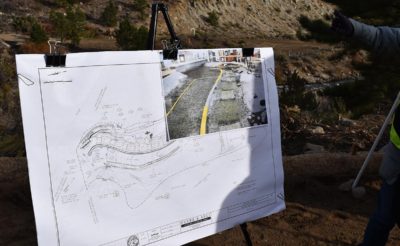
A display at the Homestake project open house shows an engineering drawing of the project and a photo of a scale model used to validate the design. The site model was constructed in Canada and subjected to flows equivalent to a 100-year flood (photo by Joe Stone).
At an Oct. 18 open house for the project, Gwen Happ ‒ issues, collaboration and engagement manager with Colorado Springs Utilities ‒ said the project partners have been preparing and planning for this project for more than a decade.
She said Colorado Springs Utilities and Aurora Water are providing the bulk of the project funding with Colorado Parks and Wildlife and the Colorado Water Conservation Board providing $1.2 million in grants. Pueblo Board of Waterworks, which also receives some Homestake water, is donating the easements needed to construct and maintain the structures.
Happ said portage paths will be provided for boaters for the duration of the project and that the boat chute is expected to be open for use prior to the 2020 whitewater boating season. Boaters should also be aware that the Clear Creek North River Access is closed to the public during the project.





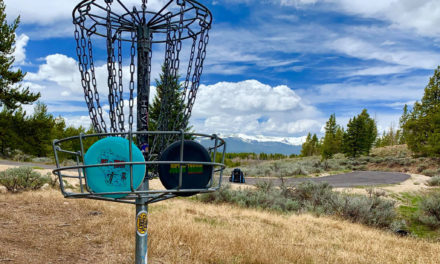
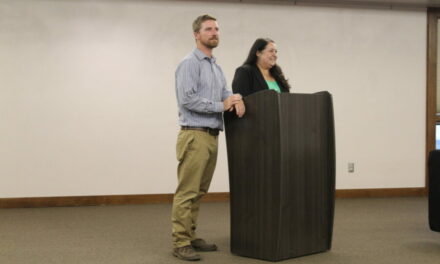

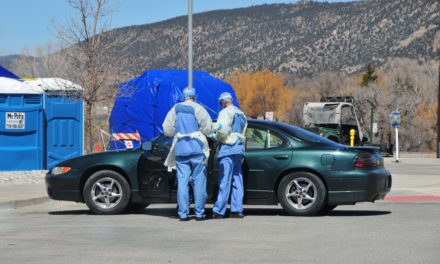

Recent Comments